Expert Water Extraction Services to Safeguard Your Property from Damage
Expert Water Extraction Services to Safeguard Your Property from Damage
Blog Article
The Refine of Water Damage Clean-up: Guaranteeing Your Home Is Recovered Successfully
Water damages can be an overwhelming obstacle for homeowners, necessitating a precise and organized clean-up procedure to restore safety and security and performance. Originally, a thorough assessment is important to identify the degree of the damages and figure out the proper removal actions. Following this, effective water removal strategies play an essential function in minimizing further harm. Nonetheless, the subtleties of drying, sterilizing, and eventual reconstruction are just as crucial and usually overlooked. Recognizing these phases can make a significant difference in the result of your home's remediation, motivating a closer consider what each action involves.
Analyzing the Damages
Upon finding water damage, the very first action is to thoroughly evaluate the degree of the influence. This preliminary examination is crucial, as it aids identify the essential steps for effective cleanup and remediation. Begin by inspecting the impacted locations, including wall surfaces, ceilings, floors, and personal belongings, to determine the resource of the water invasion, whether from flooding, leakages, or condensation.
Documenting the damage is essential for both insurance claims and preparing restoration efforts - damage restoration services. Use photographs and written notes to capture the severity of the damages, keeping in mind any kind of affected architectural aspects and materials. Pay special interest to areas that may not be quickly noticeable, such as behind walls and under rugs, as hidden wetness can lead to additional issues, including mold growth
In addition, assess the timeline of the water exposure. The longer the products stay damp, the better the potential for damage. Recognizing the duration of direct exposure will notify the urgency of removal efforts. Eventually, a detailed evaluation prepares for an effective water damages cleaning process, making certain that all impacted areas are dealt with efficiently and completely.
Water Removal Strategies

Experts typically employ submersible pumps for larger quantities of water, which can promptly relieve flooding in basements or other influenced areas. For smaller quantities, wet/dry vacuums are usually made use of to extract recurring wetness from carpetings and hard surfaces. In addition, using portable extractors permits targeted removal in constrained spaces or locations with fragile materials.
In instances of contaminated water, such as sewer or floodwater, advanced removal strategies may include the use of biohazard tools to make sure safety and security and conformity with health and wellness guidelines. High-powered removal tools are important in decreasing water retention in architectural products, which can result in mold and mildew growth and architectural degeneration if not attended to without delay.
Ultimately, the effectiveness of water removal strategies plays a critical function in the total success of the water damages cleaning process, laying the groundwork for subsequent remediation initiatives.
Drying and Dehumidification
When standing water has been effectively drawn out, the following critical stage in the water damages cleaning process is drying and dehumidification. This step is vital to avoid additional damage and mold and mildew development, which can take place within 24 to 48 hours in wet atmospheres.
To achieve reliable drying out, specific devices such as industrial-grade air movers and dehumidifiers is employed. Air movers flow air across damp surfaces, improving evaporation rates, while dehumidifiers minimize humidity levels in the air, advertising a favorable atmosphere for drying. The mix of these tools makes sure that dampness is drawn out from home furnishings, walls, and floors, allowing them to dry thoroughly.
It is essential to check the drying process water damage cleaning very closely. Professionals often go to this web-site utilize wetness meters to examine the wetness web content in numerous products, ensuring that all affected locations get to appropriate dry skin levels. This meticulous technique assists to stop covert wetness pockets that can cause architectural damages or harmful mold growth.

Cleansing and Disinfecting
After the drying and dehumidification stage is complete, the following vital step in water damage cleanup is cleansing and disinfecting the affected locations. This procedure is crucial to stop the development of mold, bacteria, and various other pathogens that flourish in moist environments.
The cleaning phase commonly involves getting rid of any type of debris, dirt, and contaminants from surface areas utilizing specialized cleansing agents. For tough surface areas, a combination of soap and water or business cleansing items is typically used. damaged homes Soft products, such as furniture and rugs, might need a lot more comprehensive cleansing approaches, consisting of steam cleaning or deep extraction methods, to guarantee extensive cleanliness.

Sterilizing follows cleaning, using EPA-approved anti-bacterials to eliminate dangerous bacteria. This action is essential, specifically in locations that may have come into call with floodwaters or sewage, as these resources can pose significant health and wellness risks.
In addition, it is vital to deal with any staying smells, which might require making use of smell neutralizers or advanced methods like ozone therapy. Proper cleansing and disinfecting not just bring back the safety and hygiene of your home but additionally lay the groundwork for successful repair and fixings in subsequent stages of the water damages cleanup procedure.
Restoration and Fixings

As soon as the analysis is full, restoration efforts can begin. Additionally, flooring might need similar focus, depending on the level of water exposure.
It is critical to involve experienced restoration specialists throughout this procedure, as they have the expertise to deal with complicated repair work properly. They can assist mitigate prospective future issues, such as mold and mildew development or structural instability, hence making certain a habitable and secure living environment. Inevitably, efficient restoration and fixings restore the home's stability and boost its total worth.
Final Thought
Finally, the process of water damage cleanup is vital for restoring a home to its pre-damage problem. Each stage, from assessing the damage to executing reliable water extraction strategies, complied with by extensive drying, disinfecting, and essential repair work, plays a necessary role in guaranteeing safety and security and conformity with building requirements. Effective implementation of these actions not only mitigates instant damage however additionally improves the lasting stability and worth of the residential or commercial property.
Water damage can be an overwhelming difficulty for home owners, demanding a careful and organized cleanup process to restore safety and security and performance. Ultimately, a thorough evaluation lays the groundwork for a successful water damages cleanup process, making sure that all impacted areas are attended to efficiently and completely.
Effective water removal methods are necessary in alleviating damages and stopping further difficulties complying with a water invasion occasion.In final thought, the process of water damage cleaning is essential for recovering a home to its pre-damage condition. Each stage, from examining the damages to executing reliable water removal strategies, adhered to by comprehensive drying out, sterilizing, and required repair work, plays an essential role in ensuring safety and compliance with structure criteria.
Report this page